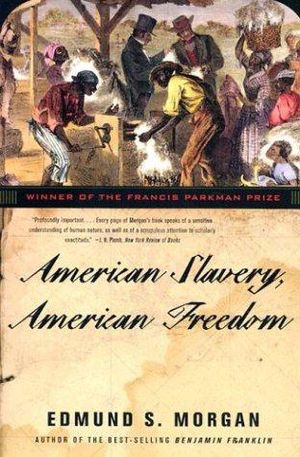American Slavery, American Freedom - Book Review

Edmund Morgan's "American Slavery, American Freedom" explores the dynamics of pre-Revolutionary Virginia from its failed Roanoke colony to the eve of revolution. Morgan reveals the changing demographics, economics, social structures, and political developments of colonial Virginia that contributed to its adoption of slavery.
Morgan divided into four broad sections: The Promised Land, The Volatile Society, and Slavery and Freedom. Morgan explained how Virginia became a central actor in the revolution contributing to the formation of republican ideology and government leadership (in terms of contributions to the Constitution and as head of the executive branch) after the War for Independence while paradoxically championing the burgeoning use of slave labor.
In the book's first half, Morgan illustrates the conditions in Virginia that led to its use of indentured servitude along with the development of concurrent political processes that allowed wealthy "big men" to dominate. Under the Virginia Company, Jamestown fared poorly in the initial years due, according to Morgan, not from lack of organization or political leadership but rather the type of immigrants that arrived. Too many of the new Virginians could be placed in two categories. One group were gentlemen for whom work remained a disturbing activity. Those from the lower economic strata dominated the second group. Unfortunately, due to widespread unemployment in England, they had grown accustomed to not working much at all.
The absence of labor combined with an abundance of land placed a premium on workers. Thus, when tobacco (despite the best efforts of the local government and others) emerged as the colony's saving grace (especially in the boom period of the 1620s), the importation of indentured servants rose dramatically. Both the legislature and individuals treated these servants harshly and brutally. The treatment administered to servants far exceed practices in England. Morgan points out that Virginians' attitudes toward such workers enabled the later shift toward slave labor, "Virginians could be so heavily exploited, legally and illegally … because they were selected for that purpose: they were brought to the colony in order to be exploited."
As tobacco profits shrunk, wealthier men of the colony began using government office as a means of financial support. Additionally, though the land had been plentiful initially, by the 1660s, its availability from a small tobacco farmer's viewpoint had shrunk significantly. The mostly male immigrants that had earned their freedom from servitude found it increasingly difficult to lay claim to the land of their own. The importation of even more workers, many of whom were of the "lesser" more "base" sort, combined with the complaints of more elite planters who also suffered as tobacco prices dropped, led to a toxic mix of discontent.
Through its use of indentured servitude, Virginia had already established a plantation system, though with slightly different parameters than those that would develop under plantation slavery. Lower mortality rates, reduced immigration from England, a decline in competition with sugar plantations in the West Indies, and the threat of former servant insurrections, i.e. Shay's Rebellion, all delayed the adoption of slavery. However, once established, it quickly was adopted throughout Virginia.